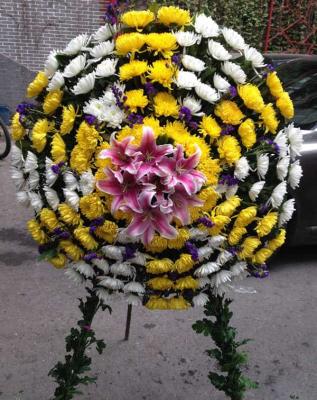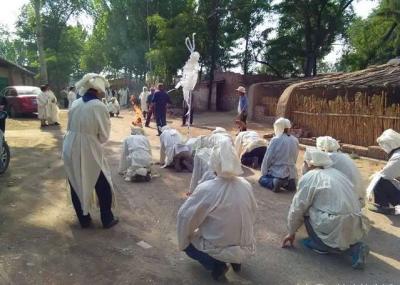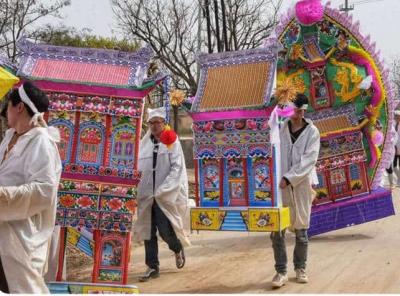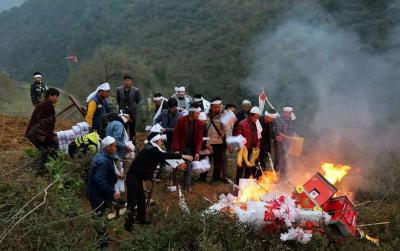Funeral Traditions and Customs in China
China has a vast territory with diverse cultures. The thousand-year-old funeral traditions may vary from place to places. In Chinese thoughts, through the funeral process, Chinese people are trying to set up a connection/dialogue between the living and the dead. Then an intangible knot can be formed for the living to show their respect to and convey the remembrance of the departed. In this sense, Chinese funeral traditions and customs reveal the deep connotation of the Chinese outlook on life and death.
Here below are the traditions and customs of Chinese funeral in the old days.
Funeral Preparation

In fact, the funeral preparation starts several years before the death of the senior. According to the Confucius principle of filial piety, it is the responsibility of the children and younger family members to do the preparations. 10-15 years ago, in the rural areas, it was quite common to see unused coffins placed in an empty room of the farmers’ houses. When the elderly people are more than 70 years old, they would consider requesting their children to make a coffin for themselves. Traditionally the deceased should be buried after death to keep the body in a certain period. In recent years, the Government promotes cremation all over the country, the cremation rate in the city reaches nearly 100%, while in the countryside (especially in remote areas), earth burials are still practiced as there might be no crematorium in the vast rural area.
The materials for coffins include pottery, wood, gold, and copper in history. After the Spring and Autumn Period (770-476 BC), wood is the more widely used for building a coffin. And pine and cypress wood is preferable, as these trees symbolize longevity in Chinese culture. Instead, Chinese never use the willow as the material to make a coffin, because the willow does not produce solid seeds (but catkins), this may herald no descendants to carry on the family lineage in the Chinese mindset.
Besides, during the leap year and month, younger family members would also make the grave-clothes (shroud) for their senior parents. There are some strict rules and taboos in making the shrouds. The material should preferably be cotton or silk. No satin is used to make shrouds, because satin has the same pronunciation as “Duanzi (Chinese: 断子)”, which implies cutting off offspring. Also shrouds cannot be made of leather or wool, otherwise, the deceased will be reincarnated as beasts in the next life. The grave-clothes are usually not buttoned, regardless of underwear or outerwear. The ribbons of the same clothes material are used to tie up the body. This can avoid the feuding with others in his/her next life without using traditional Chinese knot buttons. The number of shrouds on the deceased’s body should be odd, and never even, otherwise, the death scourge will come again.
You may also be interested in:
Mortuary ceremony
The whole ritual includes the steps of bathing the deceased with warm water, listening to his/her final words, putting on the shrouds, placing on a certain ‘spiritual bed’, buying water, feeding rice (饭含) and so on.
To show their respect to the dead, the family members would put some fake paper money (underworld bank notes) to the water and heat it, then use it for washing the body of the dead. This is commonly known as "buying water", which means the regular water (Yang Water) can be turned into the type suitable for the deceased (Yin water).
Feeding Rice (Fanhan) refers to putting bead/pearl, jade, grain or coin into the mouth of the deceased. This is one of the ancient funeral rituals. In history, the objects used for ‘Fanhan’ were stipulated by laws according to the status of the deceased. The purpose of "Fanhan" is said to prevent the deceased from suffering in the underworld and becoming a hungry ghost with an empty mouth. According to the rules of Ming Dynasty (1368-1644 AD), only those 5th-rank officials or above were entitled to keep precious beads in mouth after death, those 9th-rank officials or above only smaller beads, while the common people use the coins or grain.
Notification of Funeral
After the preparation is ready, the family must notify the relatives and friends of the deceased and choose a date to hold the burial ceremony. The notice rituals had been formed as early as the Zhou Dynasty (1046-256 BC). Some certain signals would be shown to tell relatives, friends and neighbors the news of someone's death in the family. White cloth and paper should be hung on the door to let people know that someone in the family has passed away. The family members are also supposed to deliver a formal notice to their kinsfolk in other different places. Even some relatives and friends already knew the news, the family members still need to go to their homes to notify them in person. Traditionally, sending an obituary notice is not only part of formal etiquette, but also a way to share the grief with the family members.
In old times, when delivering the obituary notice to the homes of relatives and friends, it is important that the son of the deceased should kneel outside and kowtow before entering the house, and tell relatives the news of the death of his parent and the time of the funeral. In some other areas, the son could only report the news outside the door, then return quickly. The rules vary from place to place.
Mourning wear
After the death of one grandparent or parent, the family members are supposed to wear a white cotton robe as a sign of mourning, which is also named as "Chengfu (成服)". In ancient times, all family members wear different mourning clothes based on their relationship with the deceased. Generally speaking, the sons and daughters-in-law should wear coarse white cloth robes, commonly known as "robe of filial piety". Their robes are not required to sew the bottom placket, instead, a hemp rope is used to tie around the waist.

The sons-in-law only wear a robe, but not the hat. It was a tradition that the family members wear filial hats with pockets, with small coins and cotton balls sewed to them. The eldest son’s hat has one cotton ball, the second son has two, the third son three, and so on. The grandchildren’s hat is featured with red cotton balls. The eldest grandson gets one, the second grandson have two, and so on. The great grandchildren have pink cotton balls on their hats. Regardless of men and women, all black cloth shoes should be covered with white cloth. If both parents are dead, the shoes have to be fully covered; if one parent is still alive, they should leave black shoe counters exposed with its original color (black), and grandchildren’s shoe counters are in red color.
Zuoqi (doing seven) ritual
“Zuoqi (做七)” literally means holding the memorial ceremony every 7 days, until seven “seventh -day ceremonies”, which will end in the forty-ninth days after the death. In ancient times, the body of the deceased had to be placed on a prepared deathbed in the main living room of the house for three days. It was said to hope that the dead can come back to life. If the resurrection doesn’t happen within three days, the family members would eventually give up. It was also believed that the deceased’s souls only know that they are physically dead seven days after death, so the mourning ceremonies must be held every seven days.
Regarding the Zuoqi ritual, there are various practices in different regions. For example, there was a custom of "Walking Seven (走七)" during the memorial ceremonies of the first, third and last ones. The married daughters and daughters-in-law would each carry a lantern and run in a race on a certain route and struggle for the first one to get home. It was believed that in this way the soul of the dead could be blessed and bring happiness to offspring. In Chinese mind, although the persons passed away, their souls would not disappear immediately and still have the same emotions like living people.
Condolence Rituals
Condolence rituals should be carried out during the 49-day mourning ceremony. After receiving the obituary, the relatives and friends would come to mourn the dead, and condole with the family of the deceased, who must make a loud cry in the room, kowtow three times and thank those who came to express their condolences. Currently, guests usually prepare a white envelope with cash money inside for the family. The amount of money put in the envelope varies depending on the relationship to the deceased, but must be in odd numbers. The money is meant to help the family pay for the funeral. In return, the family would give each guest a coin wrapped in red paper in the hope of good luck. A piece of candy would also be given to the guests, which should be consumed that day and before going home.
When setting up the mourning hall, the portrait of the deceased is placed in the middle of the table, covered with white table cloth. On the table were offerings, incense burners, candlesticks, and altar lamps burning day and night. Before the corpse is put into coffin, the lights must be kept burning all the days, so someone should stand by and prevent it from being extinguished. It is said that the flame is the soul of the dead.
Both the corpse and the coffin should never be placed in the open air. If so, it is said that the underworld life of the dead might be disturbed by the Sun and Moon, it also disrespect the gods in heaven. Therefore, as long as it is to hold a mourning ceremony, it is necessary to do it indoors or build a temporary funeral shed.
At present, especially in the city like Beijing and Shanghai, the ceremonies have been greatly simplified. People just bid farewell to the body and to attend a memorial service at the funeral parlor. Those who come to express their condolences are dressed in black (or similar color) clothes, wearing black armband with a while flower pinned on chest (from the West), and bowed three times to the body, and then walked around it to say goodbye. The guests should also express the condolences to the main family members of the deceased.
Encoffining ceremony

In ancient time, encoffinning is an important part of funeral, which can be divided into two steps. The first step - Xiao Lian (小殓) refers to dressing the dead. The person presiding over the ceremony began to dress the deceased, first lay the mats on the deathbed, and then lay the straps. Their texture depends on the social status of the deceased. No matter who he/she was when alive, the deceased should wear nineteen layers of new clothes before being encoffined. This is the first step - Xian Lian. After that, the family members wrapped the corpse with a quilt, and then tied it up tight with straps. Then put a cloth bag (called "mao", divided into upper and lower sections) on the corpse. Until now, it is almost ready to load the dead into the coffin.
In some areas, before encoffinning, certain rituals such as brightening and shutting the eyes should be implemented. After getting dressed for the deceased, one of the family members would take a bowl of mild water, dip a piece of new cotton into the water, and softly scrub the eyes of the deceased. Traditionally it should be done by the son. It is said that without this ritual, the deceased will be blind in the next life.
The second step – Da Lian (大殓) refers to encoffinning the corpse, and it is commonly called "Returning to Big House" by the Han people. This means that from now on the deceased is isolated from this world and leaves permanently from his/her loved ones. Therefore, Da Lian is the most important part of the funeral ceremony. Da Lian ceremony is usually held on the following day of Xiao Lian, which should be the third day after death (in order to wait for him to resurrect). According to the Chinese traditional custom, a layer of rice straw should be laid on the bottom of the coffin, and then a layer of yellow paper should be put over, which means that the soul of the deceased can rise high into heaven. When the family members carry the corpse into the coffin, it is the best time for them to express the deep emotions and regrets. From then on, the deceased and the families are in different worlds, and will never meet again. Therefore, the family members must burst into loud sobbing at the moment. Then the encoffinning ceremony ends. The coffin is still placed in the living room of the house until the burial.
Carrying the coffin to cemetery and burial ceremony
The family of the deceased would consult the local geomancer to determine the burial date. Upon the day, relatives and friends gather at the mourning hall, bringing the mourning gifts to the family. At last, the eldest son of the deceased would kneel and kowtow, then he will carry the front side (big end) of the coffin on his back, and move it out of the mourning shed with the help of others, also known as "Soul Departing".
After the coffin is lifted out of the mourning hall, it will be placed on a pre-tied wood holder, usually there are various types. In some areas, it was popular to make the coffin fully cloaked with an embroidered flannelette cover (mostly bright red). For the deceased males, patterns of Loong (Chinese dragons) are used on the cover, while women, Fenghuang (Chinese phoenixes) are adopted. The cover is decorated with red, blue, and yellow cloth valances, with a variety of auspicious patterns.
Some quality coffins, together with the huge cover make them very heavy, which require more people carry on the shoulder. As a result, the number of pall bearers can starts from 8 to 16, 24, or even 32 people.
Before the coffin will be departing, the eldest son of the deceased is on his knees. He holds the clay basin used for burning underworld money, cries bitterly, and then breaks it into pieces on the ground. Chinese people believe that if the basin is broken, the deceased can take all the burnt paper money to the underworld for use.
In some places, when the coffin is taken out from the main gate of the house, the big end must come out first; after going out, the coffin must be turned around and carried to the cemetery. This means that the deceased lying in the coffin looks like a person standing. When going out with the head in front, the body and soul could possibly look back at the home and don’t want to leave. Therefore, the pall bearers must move the small end of coffin forward after going out of the house, so that the deceased can never look back and go to another world without hesitation.
On the way to cemetery, all descendants, both men and women, must cry loud in a singing style, otherwise, they will be regarded as unfilial offspring according to the old customs. It was said that if a deceased person is not accompanied by screaming cries on the way to another world, this is also not acceptable in the old traditions. In old days, to obtain a good reputation for filial piety, the children and grandchildren of the deceased have to spent a lot of time and energy on it indeed. Some better-off families chose to hire other people to cry for the dead, which was a feasible solution in the past. This is why the crying specialists can make it as a career in rural areas, those professional mourners can earn a decent income from it.
After arriving outside the village, the funeral procession would stop. The son of the deceased thanks all the relatives and friends for coming, known as "Xie Xiao (谢孝)". These people don’t have to go further. At the same time, the coffin cover will be removed. Only the family members and close relatives will follow the coffin to the cemetery. Occasionally, some families would carry varieties of the miniature paper car, house, and television to the gravesite.
You may also be interested in:
China Burial Ceremony

The burial is the final step of the funeral. In the traditions of Han people, earth burial was the most practiced form of burials. The grave is the final destination of the deceased, so selecting a spot with good Fengshui (风水) as the gravesite is the top priority for the whole family, living and dead. Those geomancers can be hired to look for the best place for burial. It was said that at an auspicious gravesite, the vitality and energy are condensed, so that the dead can rest in peace, protecting the offspring and bringing good luck to them from another world. When the set time comes according to the geomancer, the coffin will be load into grave immediately. The family members would kowtow and bid farewell to the deceased. The paper miniatures are burned by the grave, so the deceased can receive them in another world.
Folk custom says that the soul of the dead may run out of the grave at any time and follow the family to go back home. Therefore, all the participants must go around the tomb three times, and it is strictly forbidden to look back on the way home. Otherwise, seeing the traces of the dead's soul in the underworld will be detrimental to both parties.
After the burial, participants must wash their hands, and some even use white spirit to wash, with the hope of no one dying in the future, and it is used to get rid of bad luck. Later the family would thank all the instrumental players (pay them) and guests. Afterwards, a memorial tablet might be set up in the family’s house or clan temple to show respect to the deceased at any time.
On the whole, these folk traditions and customs all reflect the living people's condolence for the dead and the good wishes for life to prosper.
Related reading about real life in China: